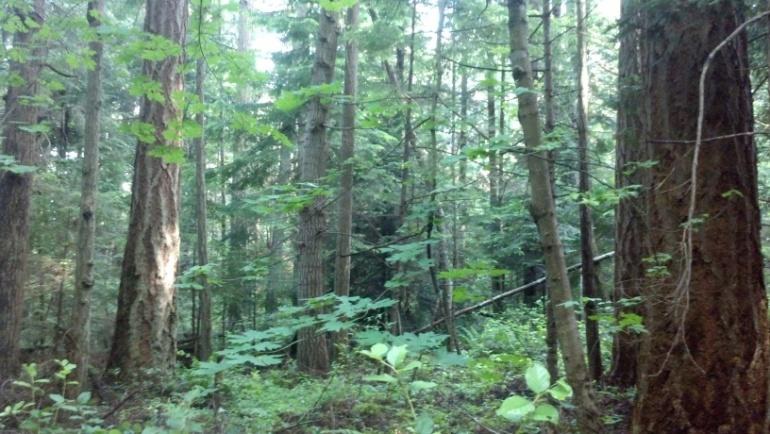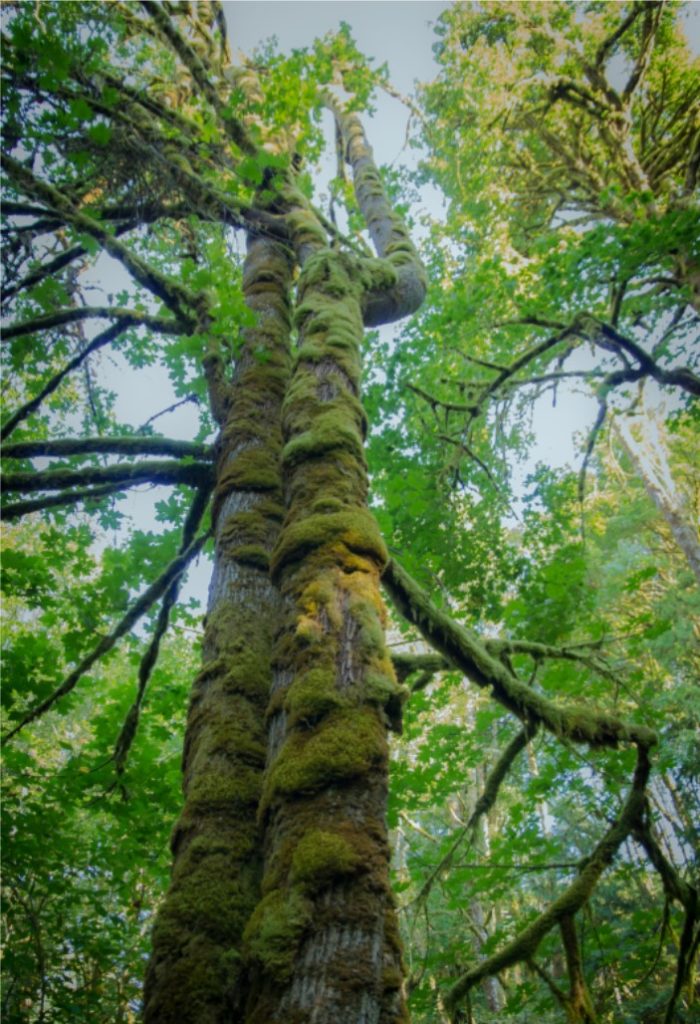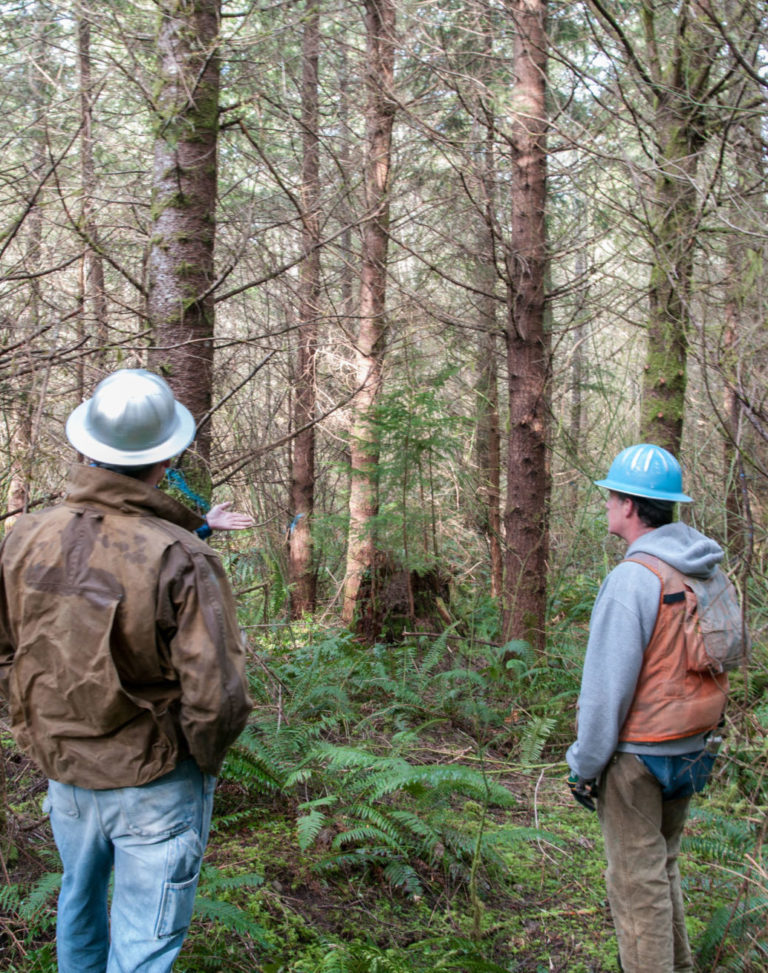Member Spotlight: A few sheep and EQIP help steward the forest

By Christina Davis and NNRG
Steve and Linnea Bensel of Nootka Rose Farm steward 32 acres of forest on Waldron Island in the San Juans.
In recent years, they accessed cost-share funds through the Natural Resources Conservation Service to develop a forest management plan and do a pre-commercial thinning in their forest. They also channel the appetites of a few woolly ruminants to stymy invasive ivy.
Steve and his wife, Linnea, both grew up as stewards of the land: Linnea’s mother was an avid gardener and Steve’s parents farmed when he was a child, informing his decision at the age of 4 to become a farmer himself. In short, the couple knew good dirt when they saw it.
The couple bought their first piece of property in 1973 and continued to purchase adjacent parcels over the years, eventually piecing together the 32 acres of Nootka Rose Farm. The land is close to the center of Waldron Island, a northwestern constituent of the San Juan Archipelago off the North Pacific Coast of Washington State. Douglas-fir, western red cedar, western hemlock, grand fir, and big leaf maple shade visitors to the forest and house an abundance of resident and migratory birds.

The couple have a strong sense of stewardship and connection to the forest.
“We both get a very deep sense of satisfaction by working in the woods,” Steve says. The forest has also provided for the couple in a more physical sense. Steve built both their house and their barn with wood from the land and affirms that “just about everything we have came out of the forest in terms of timber.”
The Bensels sought a natural form of weed control when invasive ivy started to accumulate in the woods: sheep. In the 1940s, the deer population on Waldron Island was eliminated. With no large browsing animals on island, English ivy grew rampant. Steve began to bring sheep into his forest in the winter to eat the ivy. So far, the sheep have been so effective at controlling the invasive plant that Steve recommends the strategy to other forest owners.
In recent years, it became obvious to the Bensels that the forest needed thinning. A part of their property is in Designated Forest Land program and the county assessor wanted to see some management activity. “The old plan that we had was written by the previous owner who was a high grade logger, so we needed a new road map,” Steve said.
The Bensels learned about NNRG from Christine Johnson who also owns property on Waldron Island and is on NNRG’s board of directors. Christine put them in touch with Director of Forestry Kirk Hanson, which marked the beginning of a collaborative process that would shape the future of Nootka Rose Farm. “We had the opportunity to talk to Kirk and it was like ‘ah!’ – this is the kind of advice we need. It was his knowledge and his enthusiasm that really got us going down that path.”
The couple applied for funds from the Environmental Quality Incentives Program (EQIP) to offset the costs of having a management plan written. EQIP is a cost-share program through the Natural Resources Conservation Service (NRCS) that provides financial assistance to land owners for projects that enhance the ecological value of their land. Grants can fund activities as small as habitat pile construction, pruning and installing bird boxes or as extensive as pre-commercial thinning, invasive species removal, and developing a comprehensive forest management plan. Steve admits that the EQIP application was confusing, but Kirk was quite helpful. They were awarded the grant and worked with Kirk to develop a Conservation Action Plan for Nootka Rose Farm.

“Going through the management plan process is extremely educational. Walking through your forest with Kirk and seeing it through his eyes is pretty amazing. He can project 10, 20 or 30 years down the road and say this is going to be the outcome of that.”
They laid out several short term goals like thinning to mitigate fire risks and increase understory diversity, enhancing bird forage, and providing small amounts of firewood to the Waldron community. Longer term goals include promoting forest resilience and stand structures that minimize fire risk, continue to enhance bird habitat, and conduct periodic commercial harvests to offset the management costs. Steve says the plan has clarified his and Linnea’s thoughts about the future of the forest and established a schedule of tangible management actions.
Now that the plan is in place, the question remains: “How do we do these things without going broke?” A benefit of the EQIP process is that once the initial application is in the system, it is much easier to apply for funding again. The Bensels reapplied for a 2014 pre-commercial harvest EQIP grant which was “a matter of a couple emails,” Steve says.
The small community and isolated nature of Waldron Island has proven to be a challenge for conservation activities. With the high costs of transportation, a small thinning operation has not yet proven to be cost effective, but the Bensels are not giving up. They continue to brainstorm with Kirk about options that are more economically feasible, particularly an island-wide operation that could have huge impacts in terms of fire hazard reduction. “This entire island is pretty much overstocked. If we were to have a drought the forest would be a tinder box.”
To Steve, “the forest is another crop. It’s on a different time scale but still requires management.” In this sense, Steve Bensel is fulfilling his childhood dream of becoming a farmer. But instead of tending a large monoculture, he is farming a small, diverse, resilient forest. “It’s kind of silly in a way, because most of what we do we will never see come to fruition. But we still do it.” Even though the pace of natural processes makes this a common sentiment in conservation work, the Bensels are inspired by their desire to pass on the land to their children someday. Their descendants will certainly be able to reap the benefits of Steve and Linnea’s ecological management, and perhaps even perpetuate the land stewardship ethic that has already crossed generations.

Leave a Reply